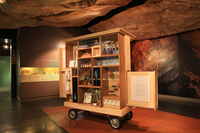Items
Site
The Medicine Chest
keywords is exactly
politics
-

Chest: a botanical ecology
Illness and disease affect us all. The treatment of these conditions however, has been vast and varied, depending on the historical periods and the cultural context in and during which they are practiced. Situated in the rock art gallery, where healing power is expressed in San paintings, this mobile set of cabinets explores a rich complex of healing practices through the display of a medicine chest which was donated to the university of Cape Town in 1978. This chest belonged to a British dentist, who practiced in Cape Town from 1904, and who bought the chest for a hunting trip he undertook in 1913 to (then) Northern Rhodesia. The idea of the chest then gives rise to a variety of forms of healing: from instruments used to exorcise evil spirits and children's letters written to celebrate a heart transplant; to medicinal flowers bought at the Adderley Street flower market. The exhibition aims to visualise and materialise illness and its treatment from historical, cultural and disciplinary perspectives. Drawing on well-established historical and contemporary connections between the disciplines of Botany, Medicine and Pharmacology, the exhibits also suggest latent links which are at times political, at times whimsical. -

A teeth mould guide
"The large quantity of papers in the BC666 collection pertaining to dental matters – which includes ‘legal and financial papers of the dental practice, papers of the various dental societies to which Walter belonged from 1905 to 1934’ and letters on various dental matters, as well as a large section devoted to correspondence, memoranda and notes on the Medical, Dental and Pharmacy Act of 1928 – shows he was ‘very active in dental politics’ (Hart & Lydall 1981: 1). As an 'office-bearing member of the Dental Society of the Cape Province, and a member of the South African Dental Association, he was the key figure in formulating and presenting the dentists’ case against unqualified dental mechanics in the proposed new medical bill, which was passed in 1928 as the Medical, Dental and Pharmacy Act' (Hart & Lydall 1981: 1). This act was considered a milestone in the development of organised medical, dental and pharmaceutical practices in South Africa, establishing a single set of regulations for these professions across the country (Ryan 1986: 149–151). It was also, however, one of a series of laws passed in South Africa that have regulated indigenous medical practices since the 19th century. Legislation passed in 1862 prevented sangomas from practicing (Paarl in Bishop 2010: 14), and the 1928 act barred inyangas from practicing in all parts of the country except Natal, where they could continue to practice if granted a license (Flint in Bishop 2010: 14–15). The act also banned the indigenous use of ‘European’ methods of diagnosis and treatment, for example forbidding the use of stethoscopes by inyangas (Bishop 2010: 16)" (Liebenberg 2021: 53 - 55). -

Floyd in Northern Rhodesia
"In 1913, Walter Floyd undertook a hunting trip with a few of his friends to (then) Northern Rhodesia. It was prior to embarking on this trip, that he purchased the No. 254 medicine chest in the Burroughs Wellcome & Co shop in Cape Town. "With the exception of an occasional Portuguese explorer, the area that became known as Rhodesia lay largely untouched by Western intervention until the mid-19th century. It was only after 1851, when the Scottish missionary and explorer David Livingstone entered this terrain, that accounts of it spread to London and further afield (Taylor 2006: 11). However, a significant number of explorers, missionaries and traders began to arrive in the region after the Berlin Conference (1884–1885) (Simson 1985: 7), and in 1890 Cecil John Rhodes, spearheading British imperial interests in the area, secured, through trickery and deception, exclusive mining concessions from the local chiefs for the British South Africa Company (Taylor 2006: 11). By 1895, the area, now renamed Northern and Southern Rhodesia after Rhodes, was proclaimed a British sphere of influence" (Liebenberg 2021: 57)


